Exploring the Art and Science of Shark Chumming
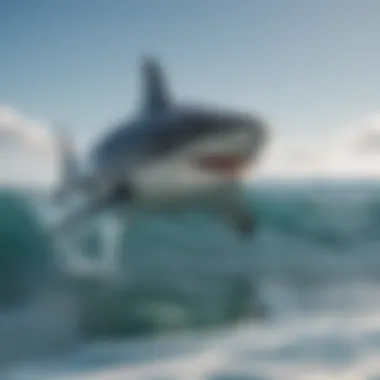
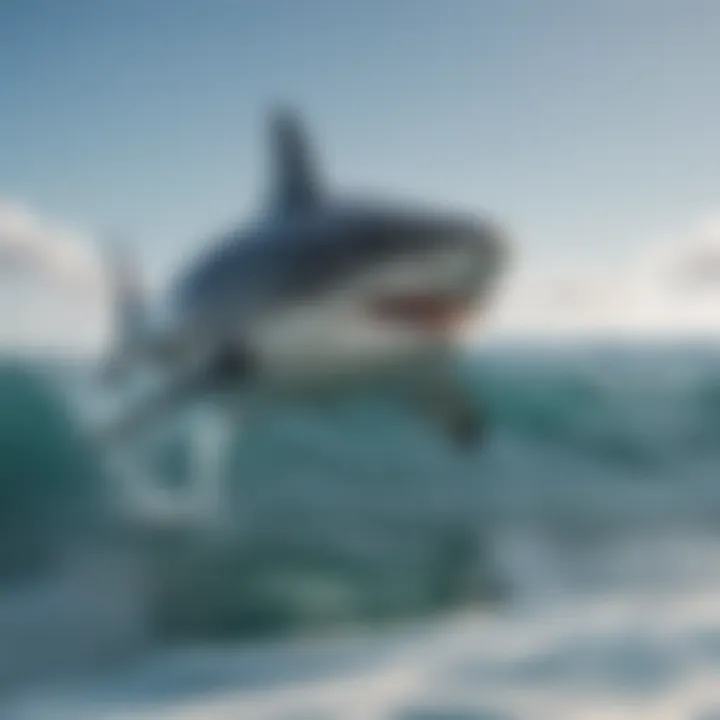
Intro
Chumming for sharks is more than just a means of attracting these incredible creatures; it embodies a blend of time-honored tradition and empirical science. As water sports enthusiasts and outdoor adventurers seek to engage more deeply with marine life, understanding the art and science behind chumming becomes essential. This practice, often deemed controversial, raises questions not just about fishing techniques but about ethical considerations and our responsibilities toward marine ecosystems.
At its core, chumming involves creating a scent trail in the water to lure sharks closer to a specific area. This can be done using various materials, with old fish scraps or specialized chum mixes being common choices. However, the intricacies of the practice extend far beyond mere bait; they encompass knowledge of shark behavior, environmental signals, and the surrounding marine world.
As we dive deeper into this topic, we will explore different techniques utilized in chumming, safety measures necessary to ensure a secure experience, and the ethical implications that underlie this potent interaction with apex predators. Understanding these subtleties allows for not just a thrilling underwater encounter but also a conscious effort toward conservation and respectful engagement with marine life.
Techniques and Skills
Fundamental Techniques for Beginners
For those new to the world of chumming, starting with fundamental techniques is crucial. It’s not just about tossing out a few fish scraps and hoping for the best; it requires a structured approach to effectively draw in sharks while minimizing potential harms to both the creatures and the environment.
- Understanding Shark Behavior: To develop an effective chumming strategy, one must recognize what draws sharks into an area. Factors such as water temperature, tide movements, and even moon phases can influence shark activity.
- Creating Chum: A basic recipe might include chopped fish, fish oils, and blood, all blended to create a potent scent. Make sure to mix the ingredients well to maximize the scent dispersion when the mixture hits the water.
- Chum Dispersion Method: Use a mesh bag to contain the chum, allowing it to break apart gradually in the water. This method not only keeps your boat clean but also releases the scent over a larger area without overwhelming the sharks.
Advanced Skills for Experienced Athletes
Once comfort with the basics has been established, experienced chummers can delve into more advanced techniques. These methods often require keen observation and adaptability.
- Selective Chumming: This involves targeting specific species of sharks by tailoring the chum composition to their preferences. For instance, larger pelagic sharks might respond better to oily fish, while reef sharks may prefer softer, less oily options.
- Timing and Location: Expert chummers understand the significance of local marine patterns. Utilizing knowledge about typical feeding times and seasonal movements can vastly increase the chances of a productive chumming experience.
- Monitoring Water Conditions: Use water clarity and temperature readings to inform your chumming technique. This can give clues to the presence of sharks and other fish species within the vicinity.
"Chumming is not about the quantity of fish you attract but the quality of the interaction you create with the surrounding marine life."
As such, honing your skills goes hand-in-hand with respecting the ocean's balance and striving to promote conservation efforts.
Safety and Gear
Essential Safety Measures for Chumming
Safety should never be an afterthought when venturing into shark territory. Preparation is key to ensuring both personal safety and the welfare of the sharks. Here are some indispensable safety measures:
- Stay Aware: Always maintain situational awareness. Watch for sharks approaching and ensure all participants in the boat are vigilant.
- Emergency Equipment: Equip your boat with life jackets, first aid kits, and emergency flotation devices. These tools can be lifesavers in unforeseen circumstances.
- Communication Tools: Carry reliable communication devices to stay in touch with others, especially when off the grid.
Gear Reviews and Recommendations
Selecting the right gear can greatly influence your chumming experience. Here are some recommended items:
- Rod and Reel: An excellent choice for a chumming setup would be a Shimano Saragosa SW reel paired with an Ugly Stik Bigwater rod. This combination gives a sturdy feel, even with large sharks.
- Chum Bags: The Fish-Under-Pressure chum bag is ideal for keeping chum contained while allowing scent to escape.
- Safety Floatation: Invest in a quality inflatable float to have handy when dealing with larger predatory fish.
By considering these techniques, skills, safety measures, and gear recommendations, you're not merely equipped to engage with sharks; you’re prepared to do so in a thoughtful manner that respects the inherent value of marine ecosystems. The right preparation paves the way for a rewarding and responsible interaction with these majestic creatures.
Preamble to Chumming for Sharks
Chumming for sharks stands at the crossroads of art and science, revealing a deeper understanding of marine ecosystems. For those who partake in water sports and outdoor adventures, this practice isn't merely a means to encounter these majestic creatures; it augments our comprehension of predator-prey dynamics and the delicate balance within the ocean's food web. Chumming serves several purposes—it can enhance fishing experiences, aid in scientific research, and even foster connection between humans and sharks, which is often overlooked in discussions about conservation.
Definition and Purpose
Chumming involves the deliberate introduction of bait—often in the form of fish parts or other organic matter—into the water. This practice attracts sharks towards a specific area, allowing enthusiasts and researchers to observe shark behavior more closely. The primary goal is to lure these apex predators, promoting encounters that can lead to improved understanding of their feeding habits and general biology. Beyond just attracting sharks, chumming has been instrumental in scientific endeavors, as researchers can gather crucial data on shark migration patterns, feeding frenzy behavior, and even their responses to various chumming strategies.
The rationale behind chumming goes beyond mere curiosity; it's about engaging with the ocean's mightiest inhabitants while ensuring their ongoing conservation. By understanding sharks better, we can advocate for their protection and informed management of their populations.
Historical Context of Chumming
Historically, chumming isn't a modern concept. It dates back centuries, with fishermen utilizing bait to gather fish for sustenance. However, the systematic approach of attracting sharks specifically has roots in both traditional fishing practices and evolving marine research methodologies. Sailors and fishermen noticed that particular scents would draw in sharks, and this knowledge was passed down through generations, becoming part of the fabric of coastal communities.
In the 20th century, advances in marine biology significantly influenced chumming techniques. Scientists began to apply more structured methods for studying shark ecology, utilizing chumming as a tool not just for sport but also for serious research. This epoch marked a shift—what was once a simple fishing tactic gradually transformed into an essential practice within marine conservation efforts.
"Chumming is not just about attracting sharks; it’s about understanding their world and advocating for their future."
As our understanding of the ocean environment expanded, so did the ethical considerations around chumming. Today, the practice is scrutinized more than ever, balancing the need for enjoyment, data collection, and the consideration for shark welfare. This intertwining of elements—historical traditions, scientific purpose, and ethical debates—forms the core narrative of chumming for sharks, making it a profound topic worth exploring more deeply in the subsequent sections.
Understanding Shark Behavior
To truly appreciate the practice of chumming for sharks, one must first grasp the intricacies of shark behavior. This understanding plays a pivotal role not just in ensuring effective chumming but also in safeguarding both the sharks and those who interact with them. Understanding these majestic creatures enhances our respect for them, fostering a more responsible and conscious approach to marine activities.
Predatory Instincts and Feeding Patterns
Sharks are often the embodiment of instinctual prowess in the marine world. Their predatory behavior is finely tuned, developed over millions of years of evolution. Primarily, sharks are driven by their biological need to feed; their impressive physique and keen hunting instincts enable them to occupy the apex of the oceanic food chain.
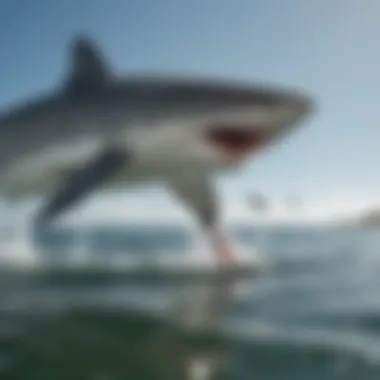
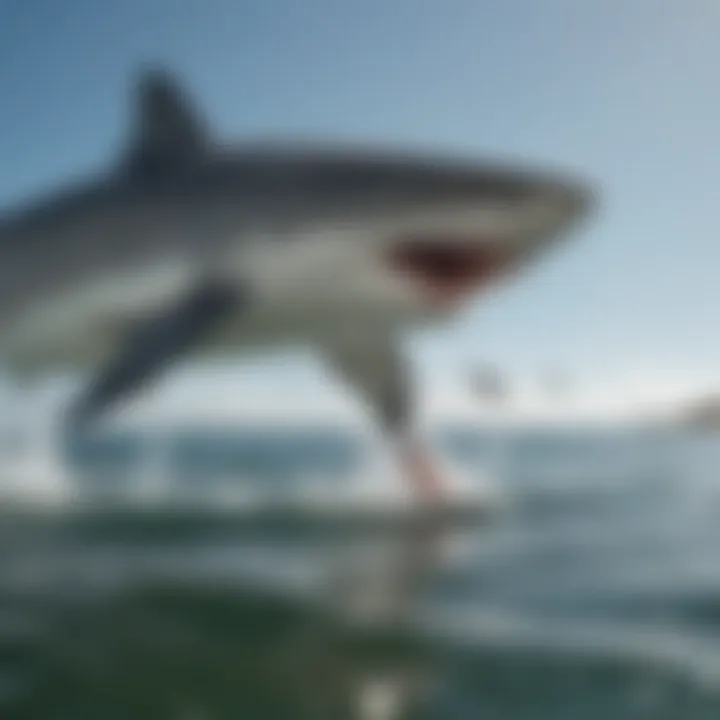
When we discuss feeding patterns, it's important to note that different species of sharks have different approaches. For instance, the great white shark is notorious for its ambush technique, effectively using stealth and power to catch its prey off guard. Alternatively, species like the whale shark are filter feeders, mainly consuming plankton without the application of aggressive hunting strategies. This variety reflects a broader range of predatory instincts that could deeply influence chumming practices.
When chumming, fishermen exploit these instinctual tendencies. A well-placed chum will lure sharks by mimicking the scent of their natural prey—this is where knowledge of their feeding habits becomes crucial. If the use of chum aligns with a shark’s feeding patterns, the likelihood of drawing them in increases significantly. This connection opens avenues for observation as well, providing unique opportunities to study and appreciate these magnificent creatures in their natural habitat.
Sensory Perception in Sharks
Another essential aspect of shark behavior is their sensory perception, which is remarkably advanced. Sharks rely on an array of senses to navigate their world, with some of these senses vastly different from those of humans. For example, sharks possess an acute sense of smell; they can detect blood from miles away. This olfactory prowess is essential for their feeding as it directs them towards potential sources of nourishment.
Their ability to sense electric fields through specialized receptors called the ampullae of Lorenzini further amplifies their hunting capabilities. This allows them to detect the subtle electric signals emitted by prey, especially in murky waters where visibility is compromised.
Moreover, their lateral line system detects changes in water pressure and movement, enabling them to identify nearby movement. Understanding these sensory modalities is not just of academic interest; it’s fundamentally important for practitioners involved in chumming. By recognizing how sharks perceive their environment, chummers can better tailor their techniques, ensuring they work with the sharks' natural behaviors rather than against them.
"Deepening our understanding of shark behavior is not just about enhancing sport or recreation; it's about respecting and protecting these vital ocean inhabitants."
Chumming Techniques
Chumming techniques serve as the backbone of attracting sharks, which rely on the methods fishermen use to entice them into specific locations. Understanding these techniques is crucial for anyone seeking to engage with sharks responsibly while enjoying the sport of fishing. These methods also play a role in research and conservation efforts, making this knowledge vital not just for enthusiasts but for the preservation of healthy marine ecosystems.
Through different types of chum utilized and various application methods, species-specific feeding habits, and local environmental conditions come into play. Respecting these considerations can lead to more effective chumming while minimizing potential harm to shark populations and their habitats.
Types of Chum Used
Chum isn’t just a single food source; it encompasses a range of materials designed to draw in sharks. Here are some categories of chum used extensively in shark fishing:
- Fish Mixes: Often created from blended fish scraps, this type of chum is highly effective due to its strong scent. It may include species like bonito, mackerel, or sardines and is often rich in oil, providing a potent attractant.
- Fish Cranberries: Referring to fish-offal—a mushy byproduct of fish processing—often used as a cheap and efficiently smelly option to lure in sharks. Despite sometimes being less appealing to certain species, it can work wonders in attracting more desperate feeders.
- Gel Chum: This format consists of a gelatinous mixture that is formulated to gradually release scent into the water. It tends to last longer than traditional methods and can be specific to certain species, creating targeting efficiency.
By choosing the right type of chum, fishermen can maximize their chances of drawing in the desired shark species while being mindful of the ecological impacts of their choices.
Methods of Application
Chumming methods can vary based on location, species targeted, and individual preferences. Let’s look at three notable techniques:
Drifting Chum
Drifting chum is an effective method that involves the slow release of bait while the boat is in motion. This technique capitalizes on natural currents to disperse scent over a wider area, enticing sharks to follow the trail back to the boat. One of its remarkable traits is its adaptability to various conditions. Drifting can be done in open water or close to shore, depending on where sharks are likely to be found, making it a favored approach.
The key characteristic of drifting chum lies in its passive, yet enticing nature. As the vessel moves, the scent and pieces of bait gradually diffuse, creating an alluring line that can pull in sharks from significant distances. The downside, however, is that drift rates must be carefully controlled, or else the chum can disperse too quickly, losing its effectiveness.
Chum Bags
Chum bags offer a more contained way to fish. These mesh bags are filled with various types of chum and suspended just beneath the water’s surface. The design allows for a slow release of scent but keeps the chunks of chum from dispersing too widely.
One of the benefits of using chum bags is that they minimize waste. Instead of scattering bait everywhere, they focus the attraction right where the boat is. Furthermore, the method also deters smaller fish from picking apart the bait, ensuring that sharks will be the primary visitors.
On the flip side, though, if the mesh is too coarse, larger bait might escape into the surrounding waters, reducing overall effectiveness.
Chum Plumes
Generating chum plumes involves systematically dispensing a continuous stream of chum into the water. This creates a swirling effect, delivering scent and small bits of chum in a concentrated area. Particularly effective in deeper waters, chum plumes can stimulate the natural curiosity of sharks, encouraging them to investigate the source of the attractive smell indicated by the plume.
The main advantage of using chums plumes is the dynamic movement that can catch the attention of sharks. It creates an illusion of a feeding frenzy that is hard for sharks to resist. However, care must be taken, as overdoing it can lead to dilution, where the scent becomes too weak to draw sharks in effectively.
"Approaching shark chumming requires knowledge and respect, not just for the skill itself but for the sharks and the environment they're part of."
Overall, the method of application is as essential as the type of chum selected. These techniques require practice and a keen understanding of the local conditions to be effective. By mastering both elements, enthusiasts can create environmentally conscious and successful experiences that align with marine conservation goals.
Safety Protocols in Chumming
The practice of chumming for sharks brings its share of excitement but also presents significant safety considerations. Engaging with nature can often be unpredictable, particularly when it involves apex predators like sharks. Therefore, establishing solid safety protocols becomes essential for both the participants and the surrounding marine life. This segment delves into the risks involved as well as best practices for ensuring safety.
Understanding Risks Involved
Chumming, while a popular method for attracting sharks, is not without its hazards. Recognizing these risks is crucial. The foremost danger is the potential for shark encounters, which can escalate quickly. For instance, a feeding frenzy can cause sharks to become more aggressive, particularly if they feel threatened or excited by a sudden influx of food.
Additionally, there's an element of risk associated with being in the water itself. Strong currents, unpredictable weather patterns, or intricate underwater terrains can pose challenges even for experienced divers or fishermen. Misunderstanding these factors or ignoring warnings can lead to dire consequences.
Some risks include:
- Injuries from equipment: Sharp hooks and heavy gear can cause harm, especially in a crowded boat environment.
- Bites from sharks: Although rare, shark bites can occur. Knowing how to react can be crucial in these moments.
- Marine Environment Hazards: Jellyfish, surfacing debris, and sudden changes in water temperature can also add risk.
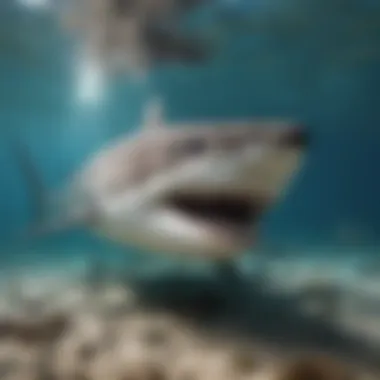
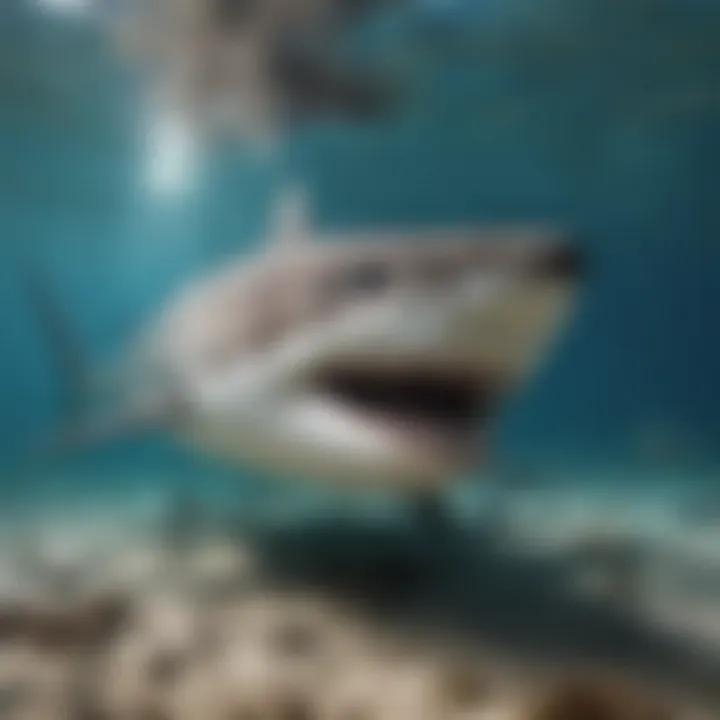
"Forewarned is forearmed.” Understanding the potential hazards can help participants prepare effectively. Familiarizing oneself with the surroundings can often be the difference between a thrilling adventure and a dangerous mishap.
Best Practices for Safety
Mitigating risks involves adopting best practices for safety. Here are several recommendations that can help ensure a safer experience while chumming:
- Educate Yourself: Learn about the behavior of sharks and the environment where chumming occurs. Knowledge about species can inform how to handle encounters.
- Use Tools Wisely: Always handle fishing gear with care. Make use of protective gloves when dealing with hooks or any sharp objects.
- Buddy System: Never chum alone. Always have a partner to assist in case of an emergency. This way, help can be summoned promptly.
- Stay Attentive: Keep an eye on not just sharks but also on fellow participants. Being vigilant can help prevent accidents before they happen.
- Practice Safe Discarding: Make sure to dispose of used materials properly to prevent attracting unwanted wildlife to the launch areas or anchor points.
- Stay Updated: Regularly check weather conditions and be aware of any changes in the marine environment. Adapting to these changes promptly is vital to ensuring safety.
- Wear Appropriate Gear: Life jackets, wetsuits, and padding can protect against potential injuries, whether from equipment or environmental hazards.
In summary, the pursuit of shark chumming can be thrilling, but safety cannot take a backseat. By understanding the risks and implementing best practices, both the enjoyment of the adventure and the integrity of marine life can be preserved.
Environmental Impact and Ethical Considerations
The practice of chumming for sharks sparks considerable discourse, especially regarding its environmental consequences and ethical ramifications. As predators at the top of the food chain, sharks play a vital role in maintaining the balance of marine ecosystems. Understanding the subtleties tied to chumming is critical not only for enthusiasts and practitioners but also for anyone invested in the preservation of oceanic life.
Shark populations have faced significant declines over the years due to overfishing and habitat loss. Chumming, while possibly beneficial for attracting these creatures for observation or study, can also present challenges that need addressing. The potential impact on shark populations and marine environments must not be taken lightly; therefore, this conversation encompasses a myriad of elements.
Effects on Shark Populations
Chumming can lead to increased shark presence in certain areas, which may have far-reaching effects on their populations. By providing a concentrated food source, chumming encourages sharks to frequent these locations, which may result in behavioral changes. It could lead to overfamiliarity with human activities—
- Increased Vulnerability: Frequent chumming spots may create a scenario where sharks become overly reliant on this artificial food source, making them more susceptible to fishing and other threats.
- Altered Migratory Patterns: Sharks have natural migratory routes, and consistent chumming can disrupt these patterns. If chum is present continuously, it may cause sharks to adapt their movement, which can impact their reproductive cycles and overall health.
It's crucial to be mindful of these changes. As much as we are drawn to the thrill of encountering these magnificent creatures, giving them a chance to flourish in their natural habitat should always remain a priority.
Debate Over Chumming Ethics
The ethical implications surrounding chumming are often contentious. Advocacy groups and marine biologists frequently engage in lively discussions on whether this practice should be embraced or curtailed.
- Natural vs. Artificial Feeding: Some argue that chumming interferes with the natural feeding habits of sharks, fostering a sense of dependency that could ultimately harm them. Conversely, others believe it provides opportunities for education and research which could benefit conservation initiatives.
- Impact on Local Ecosystems: The introduction of large numbers of sharks in an area can disrupt local fish populations and lead to ecological imbalance. This could spark a domino effect that threatens biodiversity.
- Public Perceptions: The portrayal of chumming within media influences how the public views sharks. Framing chumming as a sensational sport may romanticize the idea while overshadowing its impact on sharks and their habitats.
"With great power comes great responsibility" — this saying applies seamlessly here. Conservation groups advocate for responsible chumming practices that could educate the public about the realities of shark fisheries, offshore safaris, and ecosystems, all while mitigating any adverse effects on the sharks.
In summary, while chumming can serve a role in enhancing our connection to sharks, it is vital to navigate the waters of this practice with caution and responsibility, understanding its intricate relationship with marine life and stories that await beneath the surface.
Chumming in Popular Culture
Chumming for sharks may be a practice steeped in the ocean's misty depths, but it has made waves in popular culture. This remarkable junction of science and tradition is not only a technique used by anglers and marine biologists but also a topic that captivates the imaginations of filmmakers, writers, and the general public alike. Understanding its portrayal in media and the subsequent public perception sheds light on the complex relationship humans share with these formidable sea creatures.
Media Representations of Sharks
Sharks have often been painted in broad strokes within various forms of media. Iconic films like "Jaws" have significantly shaped our understanding—and fear—of these predators. The terror elicited by such films has perpetuated the notion that sharks are solely mindless killers, a perception that can lead to widespread misconceptions about chumming.
Here’s a couple of ways media representation influences public views:
- Fear Factor: Movies tend to exaggerate shark behavior, emphasizing their predatory aspects without acknowledging their ecological importance. Chumming, depicted as a tantalizing trap, reinforces the idea of sharks as dangerous and unpredictable.
- Fascination with the Unknown: Through documentaries like "Shark Week", audiences gain a different perspective. These programs often discuss chumming, showcasing its role in shark research and urging viewers to appreciate sharks rather than fear them.
In novels and television series, the portrayal of chumming ranges from practical applications for studying shark behaviors to dramatized encounters with the ocean’s apex predators. The literary landscape varies, too, from thrillers filled with atmospheric dread to tales that champion conservation efforts. This spectrum of representation invites opportunities for public conversations about the reality of sharks versus the myths.
Public Perception of Chumming
Public perception has a pronounced impact on the acceptance of chumming as a legitimate practice. Negative portrayals in media often overshadow its scientific and conservation-related applications. The idea of drawing sharks closer with the promise of food can spark a myriad of emotional responses ranging from intrigue to horror.
Some factors influencing this perception include:
- Commercial Fishing vs. Conservation: Many folks feel conflicted about the ethical implications of chumming, viewing it through two lenses. For some, it's a means of enhancing commercial fishing, thereby threatening shark populations. Others see it as a way to study their behaviors, crucial for conservation.
- Social Media Dynamics: Platforms like Instagram and Facebook can either demonize or humanize sharks. Visuals showcasing chumming can garner views and likes, but they can also mislead audiences about what chumming represents. It’s essential to maintain a nuanced conversation as misinformation runs rampant in these spaces.
- Activism and Advocacy: Conservation groups play a pivotal role in reshaping perceptions. They advocate for responsible chumming practices, emphasizing its potential as a tool for research and public education. Engaging the public in discussions about the ecological significance of sharks can lead to a more informed perspective.
The portrayal of chumming for sharks in popular culture—whether frightening or educational—directly influences societal attitudes towards these vital creatures.
Ultimately, chumming stands at the crossroads of fascination and fear, beckoning attention in popular culture while simultaneously raising pressing questions about ethics, safety, and responsible marine practices.
Legal Regulations Surrounding Chumming
Understanding the legal landscape surrounding chumming for sharks is essential to ensure the practice remains safe, sustainable, and responsible. Chumming attracts not only sharks but also fishermen, tourists, and conservationists alike. Each group has its interests, yet confusion often arises regarding what is permitted and what crosses into the realm of illegality. For water sports enthusiasts and outdoor adventurers, it becomes crucial to navigate these waters carefully to avoid hefty fines and contribute positively to marine ecosystem.
Local and International Laws
Chumming regulations can differ vastly from one jurisdiction to another. On a local level, many coastal regions have implemented specific laws governing chumming practices, often taking into account local shark species, their populations, and the ecological impacts of attracting them closer to shore. For example, in places like Florida, chumming is often regulated to prevent overfishing or disturbances to shark habitats. In contrast, more lenient regulations may exist in other areas, where the local economy relies heavily on tourism tied to shark viewing experiences.
Internationally, laws can be even more complex. Many countries are signatories to conventions aimed at the protection of marine life, such as the Convention on International Trade in Endangered Species of Wild Fauna and Flora (CITES). These laws restrict certain practices, including the chumming of endangered shark species, which can severely impact local populations. Hence, anyone engaging in chumming must remain acutely aware of both local laws and broader international statutes to ensure compliance.
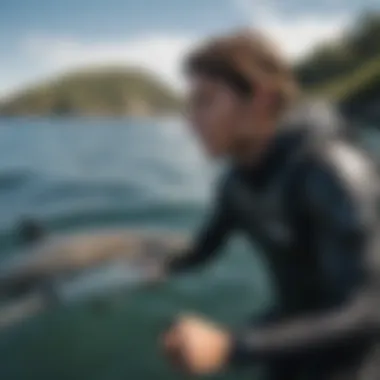

"Regulatory measures are not aimed solely at restricting activities; they seek to safeguard the delicate balance of marine ecosystems."
In summary, ignorance of local and international laws regarding chumming can lead to significant repercussions. Whether one is chumming for research purposes, sport, or tourism, it’s essential to consult relevant legal frameworks.
Role of Conservation Groups
Conservation efforts often play a pivotal role in shaping regulations around chumming. Various organizations, such as Oceana and the Shark Trust, passionately advocate for responsible practices that balance human interests with ecological health. These groups work tirelessly to raise awareness about the potential risks of chumming, not just for sharks but also for other marine wildlife affected by increased human activity in their habitats.
These organizations often engage in public education campaigns, clearly communicating the necessity for sustainable and respectful interactions with marine life. They promote data collection and research initiatives that bolster the understanding of shark behavior and populations, effectively influencing local legislation by providing empirical evidence of the impacts associated with unrestricted chumming.
In addition, conservation groups frequently collaborate with local authorities and fisheries to create frameworks that guide responsible chumming practices. These collaborations can lead to initiatives such as designated chumming zones, where recreational fishers can engage in the practice under monitored conditions, ensuring that it does not lead to overfishing or negatively affect shark populations.
Thus, the interplay between chumming practices and conservation efforts is an ongoing dialog that needs nurturing. Engaging with these organizations can not only keep adventurers informed but also foster a sense of community focused on preserving the ocean's wonders.
Best Practices for Responsible Chumming
Chumming, when conducted responsibly, not only enhances the chances of engaging with sharks but also minimizes its impact on marine ecosystems. It is crucial for practitioners to adopt best practices that align with both enjoyment of the sport and preservation of aquatic life. This balances thrill and responsibility, ensuring the shark populations remain healthy while also offering exciting encounters for enthusiasts.
Sustainable Chumming Methods
Sustainable chumming methods are the cornerstone of responsible practices. Instead of resorting to methods that may harm fish or pollute waters, divers and fishermen should consider several approaches:
- Natural Bait: Using local fish scraps rather than processed or imported options can prevent introducing foreign species into a fragile ecosystem.
- Minimal Quantity: It’s essential to use just enough chum to attract sharks without overwhelming them or disrupting their natural feeding patterns. Over-chumming can lead to dependency, where sharks begin to associate humans and their boats with food.
- Biodegradable Materials: When creating chum bags or containers, opting for biodegradable options reduces plastic pollution in marine environments. This having a longer-lasting positive impact contributes to a healthier ocean.
- Location Awareness: Practitioners should research and select locations that allow for sustainable fishing and wildlife interaction. Avoiding sensitive habitats helps protect established marine ecosystems.
By adopting these sustainable chumming methods, not only do you enhance the experience for observing sharks, but you also stand by marine conservation efforts which play a critical role in sustaining oceanic biodiversity.
Chumming as a Conservation Tool
Chumming serves a dual purpose; while it is a means to attract sharks for observation, it can also act as a powerful tool for conservation. Properly managed chumming can facilitate research, education, and awareness around shark populations. Consider the following:
- Wildlife Observation: Through chumming, researchers can better understand shark behavior, population health, and migration patterns. This data is invaluable for conservation efforts aimed at protecting these species.
- Public Engagement: Responsible chumming practices allow for safe shark diving and ecotourism opportunities, promoting a connection between people and marine life. This human-animal connection increases awareness and pushes for protective measures.
- Funding for Research: Profits generated from organized shark diving trips can funnel back to conservation projects. This one act can lead to more significant funding for vital research that benefits marine life.
"Involving the public through observational opportunities not only boosts appreciation for sharks but can also lead to advocacy for their protection."
By recognizing chumming’s role in conservation, individuals and organizations can transform what may seem like a simple baiting practice into a proactive strategy for preserving our oceans. The key is to approach it with respect, knowledge, and care, using it as a stepping stone to enhance our understanding and appreciation of these magnificent creatures.
Future Perspectives on Shark Chumming
The future of shark chumming is a matter of great significance, not just for those who engage in this practice, but for the broader conversation surrounding marine conservation and ecological balance. As surging interest in sustainable fishing and responsible interaction with marine life grows, the methods and motivations behind chumming are evolving.
Technological Advances in Chumming Techniques
Advancements in technology hold great promise for improving chumming techniques. Innovations in artificial intelligence and marine tracking systems enhance our understanding of shark migratory patterns and behavior. For instance, buoys equipped with sensors can help identify the optimal times to deploy chum. This data-driven approach minimizes waste and increases the efficiency of attracting sharks.
Also, developments in biodegradable chumming materials present an eco-friendly alternative. These materials break down in water, reducing environmental impact, and may attract sharks effectively. Smart devices that connect to fishing line can signal the best times to chumming, allowing for a more interactive and informed approach. In essence, technology can bridge the gap between tradition and modernity, evolving chumming into a practice that respects both sharks and the environment.
Public Education and Awareness Efforts
Public education plays a critical role in shaping perceptions of shark chumming. Misunderstandings surrounding the technique can lead to fear and misinformation, which in turn can affect shark populations negatively. Educational campaigns focusing on the ecological role of sharks and the science behind chumming need to be intensified.
Such efforts could include:
- Workshops for anglers that emphasize ethical practices in chumming.
- Community seminars intended to foster discussions on wildlife conservation and the importance of sharks to marine ecosystems.
- Online resources, particularly on platforms like Facebook and Reddit, can act as discussion forums where enthusiasts share their experiences and insights, demystifying the practice.
By raising awareness, we can foster a culture of respect and conservation, ensuring that chumming is viewed as a responsible practice within the larger context of marine management.
Through informed discussions and advancements in technology, shark chumming can transform into a sustainable practice that balances the needs of fishermen with conservation goals.
Ending
The exploration into chumming for sharks leads us to an understanding that marries technical know-how with a respect for the environment. Recognizing this practice's complexity is key for any water sports enthusiast eager to engage responsibly. Chumming serves not just as a method for attracting these magnificent creatures, but it also opens a dialogue about our role in marine conservation and how we can participate mindfully.
Recap of Key Points
Throughout this discussion, we highlighted several critical elements of chumming:
- Definition and Purpose: Chumming is more than just bait; it’s a way to interact with nature’s apex predators in their habitat.
- Understanding Shark Behavior: Knowledge of shark instincts and sensory perception informs how chumming is executed effectively.
- Chumming Techniques: Various methods and techniques reveal the nuanced approach different fisheries take—each with its advantages.
- Safety Protocols: Emphasizing best practices in this high-stakes environment ensures safety for both humans and sharks.
- Environmental Impacts: Acknowledging the ecological implications of chumming helps maintain the delicate balance in shark populations.
- Legal Regulations: Awareness of local and international laws surrounding chumming can guide sustainable practices.
- Future Perspectives: Advancements in technology and education will shape the future of responsible shark chumming, emphasizing conservation.
Call for Responsible Practices
As we close our discussion, it's essential to underscore the need for responsible chumming practices. Engaging in chumming should not be merely for thrill or leisure but with a commitment to uphold ethical standards. This involves:
- Educating Every Participant: Ensure everyone involved understands the environmental significance of their actions.
- Respecting Local Regulations: Follow the guidelines laid down by conservation authorities to safeguard marine life.
- Minimizing Waste: Proper disposal of materials is crucial in preserving the integrity of marine ecosystems.
- Promoting Awareness: Share knowledge about the role of sharks in the oceanic ecosystem, fostering a community that values conservation.
- Advocating Sustainable Methods: Opt for chumming methods that reduce harm and promote ecological balance.
In summary, the practice of chumming can be an enriching experience when approached with care, respect, and a deep understanding of its implications. By making informed choices, we can enjoy our adventures while ensuring the vitality of the oceans for generations to come.















